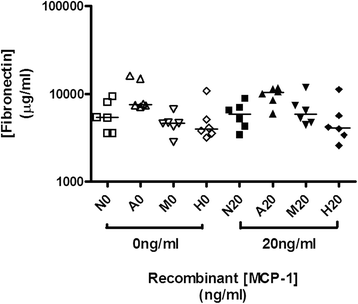CCL18 synergises with high concentrations of glucose in stimulating fibronectin production in human renal tubuloepithelial cells
- PMID: 27686838
- PMCID: PMC5041317
- DOI: 10.1186/s12882-016-0352-1
CCL18 synergises with high concentrations of glucose in stimulating fibronectin production in human renal tubuloepithelial cells
Abstract
Background: Diabetic nephropathy is the leading cause of end stage kidney disease worldwide. The pathogenesis of this disease remains elusive and multiple factors have been implicated. These include the effects of hyperglycaemia, haemodynamic and metabolic factors, and an inflammatory process that stimulates cellular signalling pathways leading to disease progression and severe fibrosis. Fibronectin (Fn) is an important protein of the extracellular matrix that is essential in fibrosis and its presence in increased amounts has been identified in the kidney in diabetic nephropathy.
Methods: Proximal tubuloepithelial (HK-2) cells were stimulated with high glucose (30 mM D-glucose) or glycated albumin (500 μg/mmol) + 4 mM D-glucose or their controls, Mannitol (26 mM + 4 mM D-glucose) and 4 mM D-glucose, respectively. Following 48 h of stimulation the supernatant was collected and MTT [3-(4,5-dimethylthiazole-2,5-diphenyltetrazolium bromide] assay performed to assess cell viability. HK-2 cells were also stimulated in the above environments with recombinant CCL18 (rCCL18) or MCP-1 (rMCP-1) for 48 h with quantification of Fn levels using ELISA.
Results: Co-stimulation of HK-2 cells with high concentrations of glucose and rCCL18 significantly increased Fn (p < 0.001), in comparison to high concentrations of glucose alone. HK-2 cells stimulated with glycated albumin consistently produced Fn and this did not alter following co-stimulation with rCCL18 or rMCP-1.
Conclusion: This study demonstrates how stimulation with a specific chemokine CCL18 in high glucose upregulates the production of Fn from proximal tubuloepithelial cells. This may be relevant to the development of renal fibrosis in diabetic nephropathy.
Keywords: CCL18; Diabetic nephropathy; Fibronectin; HK-2 cells; MCP-1.
Figures


References
LinkOut - more resources
Full Text Sources
Other Literature Sources
Miscellaneous

